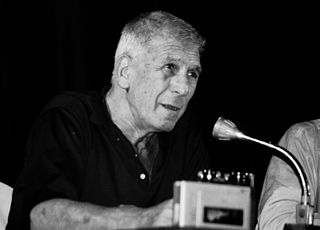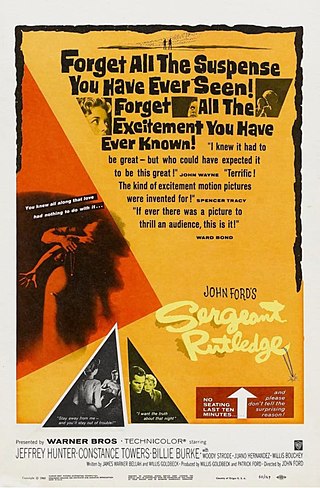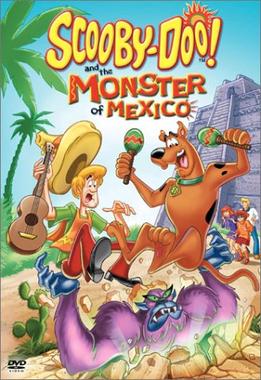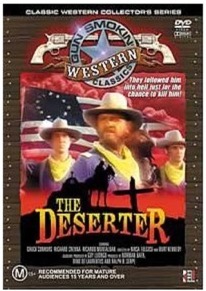
Lee Marvin was an American film and television actor. Known for his bass voice and premature white hair, he is best remembered for playing hardboiled "tough guy" characters. Although initially typecast as the "heavy", he later gained prominence for portraying anti-heroes, such as Detective Lieutenant Frank Ballinger on the television series M Squad (1957–1960). Marvin's notable roles in film included Charlie Strom in The Killers (1964), Rico Fardan in The Professionals (1966), Major John Reisman in The Dirty Dozen (1967), Ben Rumson in Paint Your Wagon (1969), Walker in Point Blank (1967), and the Sergeant in The Big Red One (1980).

Richard Brooks was an American screenwriter, film director, novelist and film producer. Nominated for eight Academy Awards in his career, he was best known for Blackboard Jungle (1955), Cat on a Hot Tin Roof (1958), Elmer Gantry, In Cold Blood (1967) and Looking for Mr. Goodbar (1977).

Red Sorghum is a 1987 Chinese film about a young woman's life working in a distillery for sorghum liquor. It is based on the first two parts of the novel Red Sorghum by Nobel laureate Mo Yan.
Michael Dennis Henry was an American football linebacker and actor. He was best known for his role as Tarzan in the 1960s trilogy and as Junior in the Smokey and the Bandit trilogy.

Woodrow Wilson Woolwine Strode was an American athlete, actor, and author. He was a decathlete and football star who was one of the first Black American players in the National Football League (NFL) in the postwar era. After football, he went on to become a film actor, where he was nominated for a Golden Globe Award for Best Supporting Actor for his role in Spartacus in 1960. Strode also served in the United States Army Air Corps during World War II.

The Appaloosa is a 1966 American Western film starring Marlon Brando, Anjanette Comer, and John Saxon, who was nominated for a Golden Globe for Best Supporting Actor for his portrayal of a Mexican bandit. The film was directed by Sidney J. Furie, and shot in Techniscope in California, Utah, and Arizona.

Delta Farce is a 2007 American war comedy film directed by C. B. Harding and stars Bill Engvall, Larry the Cable Guy, DJ Qualls and Danny Trejo. The first film after the Blue Collar Comedy Tour concert films to star both Engvall and Larry the Cable Guy, the title is a play on the Delta Force, one of the United States Army's elite special operations units alongside the Army Rangers and the Green Berets. It was released by Lionsgate on May 11, 2007 to extremely negative reviews.

Sergeant Rutledge is a 1960 American Technicolor Western film directed by John Ford and starring Jeffrey Hunter, Constance Towers, Woody Strode and Billie Burke. The title was also used for the novelization published in the same year. Six decades later, the film continues to attract attention because it was one of the first mainstream films in the U.S. to treat racism frankly and to give a starring role to an African-American actor. In 2017, film critic Richard Brody observed that "The greatest American political filmmaker, John Ford, relentlessly dramatized, in his Westerns, the mental and historical distortions arising from the country’s violent origins—including its legacy of racism, which he confronted throughout his career, nowhere more radically than in Sergeant Rutledge."
The War Wagon is a 1967 American Western heist film directed by Burt Kennedy and starring John Wayne and Kirk Douglas. Released by Universal Pictures, it was produced by Marvin Schwartz and adapted by Clair Huffaker from his own novel. The supporting cast includes Howard Keel, Robert Walker Jr., Keenan Wynn, Bruce Cabot, Joanna Barnes, Valora Noland, Bruce Dern, and Gene Evans. The film received generally positive reviews.

Duel at Diablo is a 1966 American Western film starring James Garner in his first Western after leaving the long-running tv series Maverick, as well as Sidney Poitier in his first ever Western. Based on Marvin H. Albert's 1957 novel Apache Rising, the film was co-written by Albert and Michael M. Grilikhes; it was directed by Ralph Nelson, who had directed Poitier in Lilies of the Field. The supporting cast includes Bibi Andersson, Bill Travers, Dennis Weaver and John Hoyt; Ralph Nelson has a cameo as an Army Major. The movie was shot on location amidst striking scenery in southern Utah; the musical score was composed by Neal Hefti.

Scooby-Doo! and the Monster of Mexico is a 2003 American direct-to-video animated adventure film; the sixth in a series of direct-to-video films based upon the Scooby-Doo Saturday morning cartoons. It was released on September 30, 2003, and it was produced by Warner Bros. Animation.

7 Women, also known as Seven Women, is a 1966 Metro-Goldwyn-Mayer Panavision drama film directed by John Ford and starring Anne Bancroft, Sue Lyon, Margaret Leighton, Flora Robson, Mildred Dunnock, Betty Field, Anna Lee, Eddie Albert, Mike Mazurki and Woody Strode. It was produced by Ford and Bernard Smith from a screenplay by Janet Green and John McCormick, based on the short story "Chinese Finale" by Norah Lofts. The musical score was conducted by Elmer Bernstein and the cinematography was handled by Joseph LaShelle. This was the last feature film directed by Ford, ending a career that had spanned 53 years.
Like piracy, the mercenary ethos resonates with idealized adventure, mystery, and danger, and appears frequently in popular culture. Many are called adventurers, filibusters, soldiers of fortune, gunslingers, gunrunners, ronin, and knights errant.

The Black Stallion Returns is a 1983 adventure film, an adaptation of the book of the same name by Walter Farley, and sequel to The Black Stallion. The only film directed by Robert Dalva, it is produced by Francis Ford Coppola for MGM/UA Entertainment Company.

Tarzan's Three Challenges is a 1963 British-American adventure film filmed in Metrocolor. The twenty-fifth film of the Tarzan film series that began with 1932's Tarzan the Ape Man, it is a follow-up to 1962's Tarzan Goes to India. The film was Jock Mahoney's second and final turn as the apeman, was produced by Sy Weintraub, written by Robert Day and Berne Giler, and directed by Robert Day. The film was released in June 1963, and was followed by Tarzan and the Valley of Gold in July 1966.

Branded is a 1950 American Technicolor Western film starring Alan Ladd, Mona Freeman, Charles Bickford, and Robert Keith. It was adapted from the novel Montana Rides by Max Brand under pen name Evan Evans. A gunfighter on the run from the law is talked into posing as the long-lost son of a wealthy rancher.

Tarzan and the Valley of Gold is a 1966 Eastmancolor adventure film starring Mike Henry in his debut as Tarzan. The Panavision film, the twenty-sixth film of the Tarzan film series that began with 1932's Tarzan the Ape Man, produced by Sy Weintraub, written by Clair Huffaker, and directed by Robert Day, is remembered for its very James Bond-like portrayal of a tropical-suited, globetrotting Tarzan. Released on July 1, 1966, it was followed by Tarzan and the Great River in 1967.

The Deserter, also known as The S.O.B.s and The Devil's Backbone is a 1970 Italian-Yugoslav American international co-production Western film produced by Dino De Laurentiis. It was directed by Burt Kennedy and written by Clair Huffaker.

The Revengers is a 1972 Western film written by Wendell Mayes based upon a story by Steven W. Carabatsos. The film was directed by Daniel Mann and stars William Holden and Ernest Borgnine.

Stronghold is a 1951 American-Mexican Western historical film directed by Steve Sekely and starring Veronica Lake, Zachary Scott and Arturo de Córdova. A separate Spanish version Red Fury was also made. The cost of both films was $519,000.


















